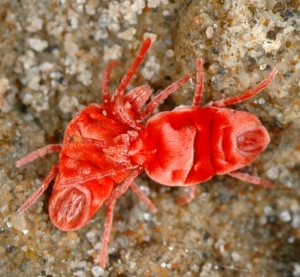A few days ago, three of my colleagues independently sent me a link to The Oatmeal’s cartoon “This is a Red Velvet Mite and He is Here to Teach You About Love“. Like many of The Oatmeal’s cartoons, this is about sex and is unabashedly rude. But unlike most of his comics, the topic in this case was one on which consider myself to be somewhat expert: indirect transfer of sperm via spermatophores.
‘Indirect’ refers to the placement of sperm packets (typically on or in stalks of hardened exudate) on a substrate by the male, with the female then picking up the sperm herself. This can be done in a paired fashion in which the male directs his deposition to a particular female, often physically contacting the female at some point (e.g., scorpions), or it can be dissociated, in which the male and female don’t interact at all (many springtails and mites). In addition to the taxa just mentioned, many other animals transfer sperm via substrate-associated spermatophores, including centipedes, pseudoscorpions, vinegaroons and even salamanders.
Velvet mites are members of the large acariform mite taxon Parasitengona, and can be roughly divided into the short-legged velvet mites (Trombidiina) and the long-legged ones (Erythraeina). Many but not all have a sparse to plush coat of setae covering their red or orange bodies. Based on the relatively little we know about sperm transfer in velvet mites, The Oatmeal got a lot of things right in his cartoon. Sperm transfer is indirect, males often lay down trails of exudates leading up to the spermatophores, females fertilize themselves, larval velvet mites are parasites, cannibalism is not uncommon (especially consumption of smaller males by larger females), and males do indeed trash the spermatophores of their competitors. But sperm blobs are small, tidy and on stalks, not giant dripping beachballs as in the cartoon. Male dancing, if it occurs, is not particularly elaborate. And what’s this about building castles out of sticks and leaves? I’ve never read anything about that. The author wasn’t forthcoming on the scientific source of the love-shack info. I searched Google Scholar for various combinations of “velvet mite*”, “Dinothrombium” (the velvet mite genus shown in the associated video), “mating” and “spermatophore*”. Nothing about castles. Perhaps the relevant publication isn’t in English? Or…could it be that The Oatmeal sometimes just MAKES THINGS UP?!?

